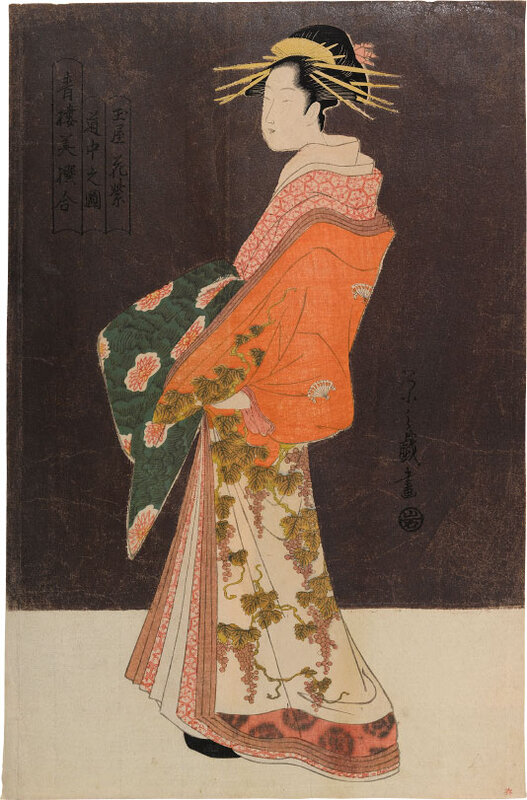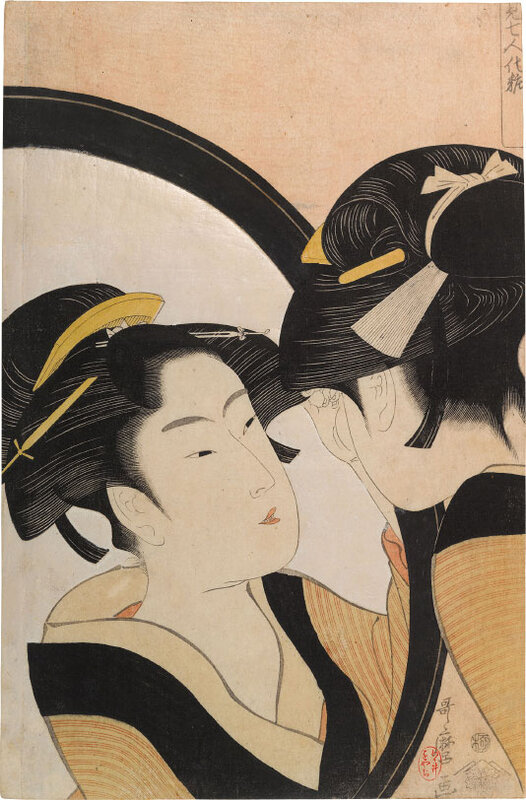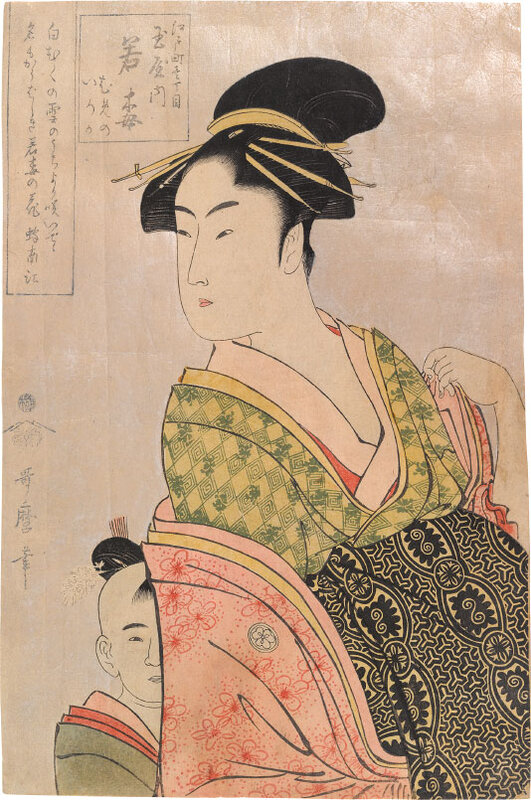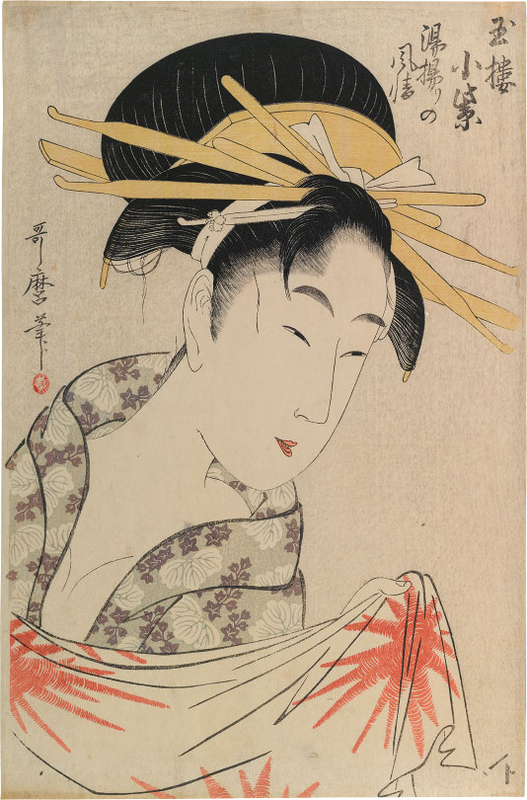Scholten Japanese Art presents 'The Baron J. Bachofen von Echt Collection of Golden Age Ukiyo-e'
NEW YORK, NY.- Scholten Japanese Art is participating in Asia Week 2020 with an extraordinary offering of Japanese woodblock prints: The Baron J. Bachofen von Echt Collection of Golden Age Ukiyo-e. The collection is comprised of a highly selective group of twenty-two figural woodblock prints produced during a period considered the highpoint of the genre, known as the ‘golden age’ of ukiyo-e, reaching its peak in the last decade of the 18th century. The prints depict bijin-ga (lit. ‘beautiful person’), the influencers of their time—famous courtesans, waitresses, and beloved actors—with works by the most acclaimed ukiyo-e artists of the late 18th and early 19th century. There are works in this collection that are possibly unique, or one of only a handful of recorded examples, with connections to some of the most prominent early collectors and dealers of ukiyo-e. In many cases, these are the only examples still remaining outside of museum collections.
The term ukiyo (lit. ‘floating world’) references an older Buddhist concept regarding the impermanence of life, but during the prosperity of the Edo Period in Japan the term began to be used to encompass and embolden everyday indulgences because of that impermanence. One of the tangible records of those indulgences was the production of nishiki-e (lit. ‘brocade pictures’), the full-color prints that we recognize today as ukiyo-e—images of the floating world celebrating youth and beauty, which began in circa 1765. After the advent of full-color woodblock printing, the market for nishiki-e, accessible to everyday people, steadily grew, and the materials and methods used to create this art rapidly evolved. A significant change that came about in the 1770s was that the craftsmen involved with production developed techniques for full-color printing on larger sheets of paper, and, as a result, this led to the general adoption of the standard ‘oban’ (approximately 15 by 10 in) size by publishers. Larger paper was followed by an increase of the scale of the figures within compositions.
An excellent example of this is the earliest print in the group, a circa 1777 design by Kitao Shigemasa (ca. 1739-1820), Geisha and Maid Carrying a Shamisen Box (15 by 10 1/8 in., 38 by 25.7 cm). Shigemasa was primarily a designer of illustrated books, producing over 250 in his lifetime, many of which were erotic in nature. With a comparatively small output of single sheet designs, the scarcity of extant Shigemasa prints belies his talent and influence on the genre. He worked with over twenty publishers, often with the innovative Tsutaya Juzaburo (1750-1797), whose impact looms large in the ‘golden age’ and likewise, in the Bachofen Collection. In 1774, the first book published by Tsutaya, Thousands at a Glance (Hitome senbon), featured illustrations by Shigemasa. Approximately three years later Tsutaya published an untitled series depicting full-length images of geisha of which this is a part.
Kitao Shigemasa (1739-1820), Geisha and Maid Carrying a Shamisen Box, unsigned, with seal Hayashi Tadamasa, ca. 1777, oban tate-e 15 by 10 1/8 in., 38 by 25.7 cm. Sold. © Scholten Japanese Art.
One of the finest prints included in this show, Woman and Servant in Snow, ca. 1790 (14 1/2 by 9 7/8 in., 36.8 by 25.2 cm), is by an artist whose work is particularly rare to the market: Eishosai Choki (fl. ca. 1780-1809). Also published by Tsutaya Juzaburo, the print demonstrates one of the hallmarks of golden age prints- the introduction of lavish printing techniques such as mica ground printing. The print is from an untitled group of four portraits of beauties presented in a dramatic outdoor setting that are among the most reproduced and coveted works in all of the ukiyo-e genre. The designs are distinctive in the way that Choki positions the figure off to the side, only occupying roughly two-thirds of the composition. In this print we see a beauty pausing beneath an open umbrella which shields her from the fat flakes of falling snow, shimmering (or shivering) against a cold mica background. She leans on the back of her burly servant who is bending over, reaching beyond the frame of the composition to clean the clumps of heavy wet snow off of her geta. Although they are a study in contrasts, she is lovely and delicate, he is solid with rough whiskers on his face, Choki conveys a sense of quiet intimacy shared between the two.
Eishosai Choki (fl. ca. 1780-1809), Woman and Servant in Snow (Sechu sho shiki jo), light silver mica ground of falling snowflakes with applied layer of gofun snow on top of her umbrella and the servant's hat, this impression unsigned and without censor or publisher seals, published by Tsutaya Juzaburo, ca. 1790, oban tate-e 14 1/2 by 9 7/8 in., 36.8 by 25.2 cm. Sold. © Scholten Japanese Art.
An example of a lavish printing is by Hosoda Eishi (1756-1829), Selection of Beauties from the Pleasure Quarters: Hanamurasaki of the Tamaya in Procession (14 7/8 by 9 3/4 in., 37.9 by 24.9 cm), which utilizes both an incredibly dramatic dark mica background as well as metallic printing on the hem of the sauntering courtesan, Hanamurasaki. This design was formerly in the esteemed collection of the French connoisseur, Henri Vever (1854-1942), and the subject of extensive research by the American collector, Louis V. Ledoux (1880-1948), who had a variant impression which he identified as a later state of the print. His research led him to conclude that there may have been four states of this scarce print, of which this (the Vever impression) is the earliest and (he thought) one of only three extant examples. Current research clarifies that this one is one of only two recorded impressions of the earliest version of the print.
Hosoda Eishi (1756-1829), Selection of Beauties from the Pleasure Quarters: Hanamurasaki of the Tamaya in Procession (Dochu no zu, Tamaya Hanamurasaki), dark grey mica background, signed Eishi giga (drawn for pleasure) with publisher's seal Iwa (Iwatoya Kisaburo of Eirindo), Vever collector's seal 'HV', ca. 1794-95, oban tate-e 14 7/8 by 9 3/4 in., 37.9 by 24.9 cm. Sold. © Scholten Japanese Art.
Another development in print production was the issuance of multi-panel prints- most typically in the format of triptychs. One of the most stunning works in the show which shares the Vever Collection provenance is a triptych by a student of Eishi, Chokosai Eisho (fl. ca. 1795-1801) titled A Glimpse of the Ogiya: Hashidate, Nanakoshi and Hanabito (triptych 15 1/8 by 28 3/8 in., 38.5 by 72 cm). This breath-taking composition presents three beautiful women who are seated in a brothel reception room decorated with an elaborate painting of a peacock covering the background wall. The three women are identified from right to left as the well-known and high-ranking courtesans. Hashidate, Nanakoshi and Hanabito. The title places them at the Ogiya brothel located in the Yoshiwara. All three courtesans worked at the Ogiya and seem to be engrossed in a private conversation away from their customers. Perhaps they are sharing an amusing story related to the folded love letter which Hashidate is handing to Nanakoshi. There are few copies of this triptych extant and almost all are now in museum collections.
Chokosai Eisho (fl. ca. 1795-1801), A Glimpse of the Ogiya: Hashidate, Nanakoshi and Hanabito (Ogiya mise ryaku: Hashidate, Nanakoshi, Hanabito), each sheet signed Eisho ga, with publisher's seal To of Yamaguchiya Chusuke, and Vever collector's seal 'HV', ca. mid-1790s,oban tate-e 15 1/8 by 28 3/8 in., 38.5 by 72 cm. Sold. © Scholten Japanese Art.
The bijin-ga of ukiyo-e were represented by beautiful women and beautiful men, and kabuki actors enjoyed celebrity-worship that would surely resonate with that of today. The Bachofen Collection includes three prints depicting kabuki actors, including a powerful bust-portrait by Utagawa Kunimasa (1773-1810), Actor Ichikawa Yaozo III as a Bandit (14 7/8 by 10 in., 37.7 by 25.5 cm). This intense okubi-e portrait of Ichikawa Yaozo III (Suketakaya Takasuke II, 1747-1818) shows the actor in the role of a yamagatsu (lumberjack), who is actually a legendary warrior in disguise. The print was made at the time of Yaozo’s performance in a play that was staged at the Miyako-za theater in the 11th lunar month of 1796. The artist Kunimasa died at the young age of only 37 with approximately 125 recorded designs with few impressions extant. Of the four known examples of this print, this is the only one currently in private hands.
Utagawa Kunimasa (1773-1810), Actor Ichikawa Yaozo III as a Bandit, Actually Mita no Jiro Tomotsuna, signed Kunimasa ga, with censor's seal kiwame (approved), publisher seal Yama-Zen (Tamariya Zenbei), ca. 1796, 11th lunar month, oban tate-e 14 7/8 by 10 in., 37.7 by 25.5 cm. © Scholten Japanese Art.
The Bachofen Collection has several highly important works by Kitagawa Utamaro (1753-1806), arguably the leading painting and print artist of his time who practically owned the market for images of beauties in the 1790s and early 1800s, until his untimely death in 1806 which marks the close of the ‘golden age’ period. In most ukiyo-e collections just one of these works would be the treasured highlight, in this collection there are nine Utamaro prints, including three okubi-e (‘big head’ or bust portraits) and one half-length portrait, each one a masterpiece in and of itself.
The earliest Utamaro print in the exhibition is a compositional tour-de-force. Dated to circa 1792-93, the print, Seven Women Applying Make-up Before a Full-length Mirror (14 1/4 by 9 1/2 in., 36.1 by 24.1 cm), was issued at the beginning of a productive period for Utamaro during which he designed a number of ambitious half-length and bust portrait images of beauties primarily in collaboration with the publisher Tsutaya. The title in the bookmark-shaped cartouche indicates this print is one from an intended series of seven, although only this one design is recorded. While the term 'sugatami' in the title refers to a full-length mirror, the composition is that of a reflection of a bust portrait of a beauty as seen from over her shoulder. The effect is to both share her gaze into the mirror, while simultaneously appreciating her coiffure from behind as well as a titillating view of her erikubi (the nape of her neck). Her facial features and the crest on her kimono suggest that this is a portrait of one of Utamaro's favorite subjects, the teahouse waitress Naniwa Okita. Tsutaya spared no expense with this production, generously embellishing the print with mica both on the background and on the mirror. The red seal to the left of the signature sheds light on the print’s provenance of having been in the hands of Wakai Kenzaburo (1834-1908), a highly influential Japanese art dealer and collector who was vital to the formation of ukiyo-e collections in Paris in the 1870s and 1880s. Wakai’s seal confirms that this exact impression was illustrated in Dr. Julius Kurth's 1907 monograph on Utamaro (the first in a European language) when it was in the hands of Rex & Co in Berlin, an early importer of Asian art; it then passed into the hands of Werner Schindler (1905-1986) of Bienne, Switzerland. Highlights from the Schindler Collection were exhibited in several cities in Japan in 1985, and this print was illustrated on the cover of the exhibition catalogue.
Kitagawa Utamaro (1753-1806), Seven Women Applying Make-up Before a Full-length Mirror (Sugatami shichinin kesho), pink ground with silver mica on the mirror, signed Utamaro ga with censor's seal kiwame (approved) publisher's mark of Tsutaya Juzaburo (Koshodo), sealed Wakai Hayashi, and oval WS (Schindler) collector’s seal on verso, ca. 1792-93, oban tate-e 14 1/4 by 9 1/2 in., 36.1 by 24.1 cm. Sold. © Scholten Japanese Art.
In about 1792-1793, the publisher Tsutaya began producing print series by Utamaro depicting half-length portraits of beauties with glittering full-mica backgrounds. These lavish images elevated print production to new aesthetic heights, establishing both Utamaro and Tsutaya as pre-eminent ukiyo-e artist and publisher, respectively. The portrait of Wakaume of the Tamaya in Edo-machi itchome, kamuro Mumeno and Iroka (14 1/2 by 9 5/8 in., 36.8 by 24.6 cm) is dated to circa 1793-94 and is associated with a group of three portraits that were likely intended as an informal triptych, each featuring a courtesan identified in the title cartouche with her house and naming her two kamuro (child attendants) with an accompanying kyoka poem. Of the three designs, this composition functions best at the central panel because the figure's body faces one way while she turns to look in the opposite direction, and one of her kamuro peeks out from behind in a rare instance of frontal portraiture. The courtesan is Wakaume of the zashiki-mochi ('having her own suite') rank of the Tamaya house, and two kamuro, Mumeno and Iroka, are mentioned in the cartouche along with a poem playing on the literal meaning of her name, Wakaume, or White Plum.
Kitagawa Utamaro (1753-1806), Wakaume of the Tamaya in Edo-machi itchome, kamuro Mumeno and Iroka (Edo-machi itchome, Tamaya uchi Wakaume Mumeno Iroka), with mica ground, signed Utamaro hitsu with censor's seal kiwame (approved), with a kyoka, and publisher's mark of Tsutaya Juzaburo, ca. 1793-94, oban tate-e 14 1/2 by 9 5/8 in., 36.8 by 24.6 cm. © Scholten Japanese Art.
The circa 1795-96 bust portrait, Painting the Eyebrows (15 by 9 7/8 in., 38 by 25.1 cm), is another masterpiece by Utamaro included in this group. It depicts a beauty leaning forward in concentration while applying make-up to her eyebrows. We catch a glimpse of her reflection from another angle in her hand-mirror, which is highlighted with mica to suggest the polished surface. This print was produced by a rather small publishing house, Isemago, about whom very little is known, which may explain why this design is extremely scarce. Of the three recorded impressions of this design, this is the only one currently in private hands.
Kitagawa Utamaro (1753-1806), Painting the Eyebrows (Mayu-hiki), signed Utamaro hitsu with censor's seal kiwame (approved), and stylized publisher's seal of Isemago, ca. 1795-96, oban tate-e 15 by 9 7/8 in., 38 by 25.1 cm. © Scholten Japanese Art.
The final Utamaro okubi-e in the exhibition is a delightful portrait of the famous courtesan Komurasaki of the Tamaya House after a Bath (15 1/8 by 10 1/8 in., 38.5 by 25.6 cm) from circa 1797-99. The portrait is of the famous courtesan Komurasaki, who held the highest rank of yobidashi (‘on call’), which meant she only could be seen by making an appointment through a teahouse, the same rank as her ‘house sister’ Hanamurasaki featured in the full-length mica-ground print by Eishi. This print bears the collector’s seal of the artist Paul Blondeau (ca. 1860-1920) and was later in the collection of Charles Haviland (1839-1921), which was sold in Paris in 1922. This print is one of only two recorded impressions of this design.
Kitagawa Utamaro (1753-1806), Komurasaki of the Tamaya House After a Bath (Yuagari no Fuzei Gyokuro Komurasaki), signed Utamaro hitsu, with publisher's seal To (Yamaguchiya Chusuke), and red oval-shaped collector's seal Buronto (Paul Blondeau) beneath the signature, ca. 1797-99, oban tate-e 15 1/8 by 10 1/8 in., 38.5 by 25.6 cm. Sold. © Scholten Japanese Art.
The exhibition will feature twenty-two woodblock prints including works by major ukiyo-e artists such as: Kitao Shigemasa (1739-1820), Torii Kiyonaga (1752-1815), Katsukawa Shuncho (fl. ca. 1780-1795), Eishosai Choki (fl. ca. 1780-1809), Hosoda Eishi (1756-1829), Chokosai Eisho (fl. ca. 1795-1801), Chokyosai Eiri (fl. ca. 1795-1800), Ichirakutei Eisui (fl. ca. 1795-1803), Utagawa Toyokuni I (1769-1825), Katsukawa Shunei (1762-1819) and Kitagawa Utamaro (1753-1806).
These prints were lovingly collected by the Baron and Baroness John & Helen Bachofen von Echt over a period of twenty years. A fully illustrated catalogue is forthcoming.
The gallery exhibition opened on Thursday, March 12th, and continues through Saturday, March 21st, 2020.

/https%3A%2F%2Fprofilepics.canalblog.com%2Fprofilepics%2F1%2F0%2F100183.jpg)
/https%3A%2F%2Fstorage.canalblog.com%2F03%2F02%2F119589%2F96711876_o.jpg)
/https%3A%2F%2Fstorage.canalblog.com%2F11%2F31%2F119589%2F94773502_o.jpg)
/https%3A%2F%2Fstorage.canalblog.com%2F20%2F83%2F119589%2F94772815_o.jpg)
/https%3A%2F%2Fstorage.canalblog.com%2F26%2F72%2F119589%2F75604929_o.jpg)
/https%3A%2F%2Fstorage.canalblog.com%2F59%2F60%2F119589%2F26458628_o.jpg)











/http%3A%2F%2Fstorage.canalblog.com%2F71%2F11%2F119589%2F126205132_o.jpeg)
/http%3A%2F%2Fstorage.canalblog.com%2F05%2F02%2F119589%2F121570920_o.jpg)
/http%3A%2F%2Fstorage.canalblog.com%2F87%2F77%2F119589%2F121450336_o.jpg)
/http%3A%2F%2Fstorage.canalblog.com%2F09%2F36%2F119589%2F120939543_o.jpg)